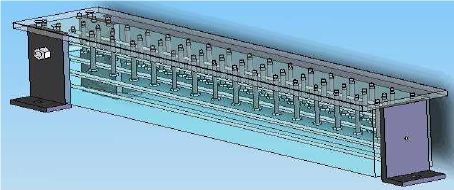Talk:Open Source Lathe
What is the first product of market value that can be produced on this lathe? Is there a demonstrable need for that product in the market place? At what point will the lathe investment pay back?
I ask, knowing that machinists are critical in the manufacturing world, but what will Factor E be manufacturing to support the costs of this tool? Are there better ways to spend the money?--Dennis 11:03, 8 March 2009 (PDT)
Seems to me that the ways need to be made much larger. The single bar shown for carying the compound and cross-slide are rather insufficient for a lathe of any critical size. The link provided to the antic Drummand lathe had a 4" diameter bar as the ways. Lesser bars are going to be insufficient. I would suggest either two or three bars of the size currently shown spread out to give more stability, or a flat set of ways as used in more standard lathes. The work required will be much more but the product should be substantially better.
This was found on the steam engine page, but is a bill of materials for a lathe. I'm not sure if it's for the same design as given here.--Conor 17:34, 23 March 2011 (EDT)
- Romig bed lathe type - from Multimachine -

- Simple prototype, $486 in materials BOM:
- 2 bearings, $50
- 2 mouning plates, 1/2"x6" angle - $40
- 4 Shaft Collars - $20
- 2" shaft - $20
- DOM tubing, 3", 2" ID - $15
- 8 3/4" bolts for table - $16
- Chuck plate - $40
- Bolts for chuck - $20
- Nuts and bolts for DOM - $5
- XY table - $70 off shelf at Enco - [1]
- Tool post - $10
- table plate - $30
- 2 bags of cement, 80 lb each - $20
- sand, gravel - $10
- TOTAL - $316
- High performance, 2/1000" accuracy with proper technique, stock parts, 1000 lb radial and 200 lb axial load capacity
No lead screw.
A lathe is nice, but a screw cutting lathe is the basis of the industrial revolution. It is the one machine which can create all the others. For instance on a mill if you don't have a screw how can you move the table accurately?
A lathe can be used like a mill. You bolt the piece to the cross slide and if you don't have a screw to move in height (to get on center with the tool bit) then you can shim the part. Accurately creating holes, both in size and relative location on a flat metal plate can be done with a faceplate using buttons. You can use a lathe as a boring machine by mounting the work on the cross slide and putting the tools on a shaft turning between centers (with a dog of course). You can make bolts to hold things together.
Many of the things I'm mentioning aren't done very much anymore due to the number of specialized machines out in the world that can do them better. Pick up an older machinist text, say 1880's to before WWI to see what can be done on these almost universal machines.